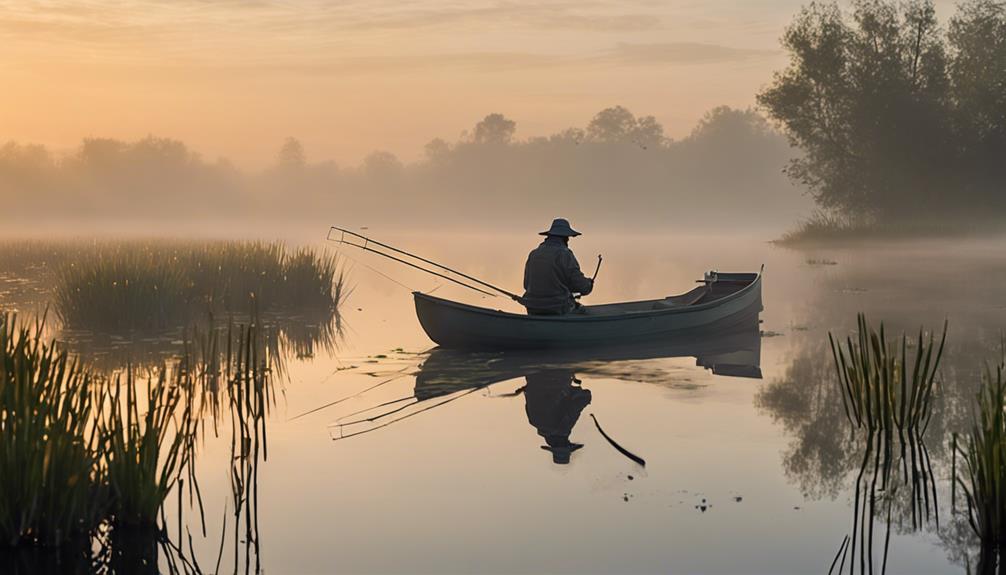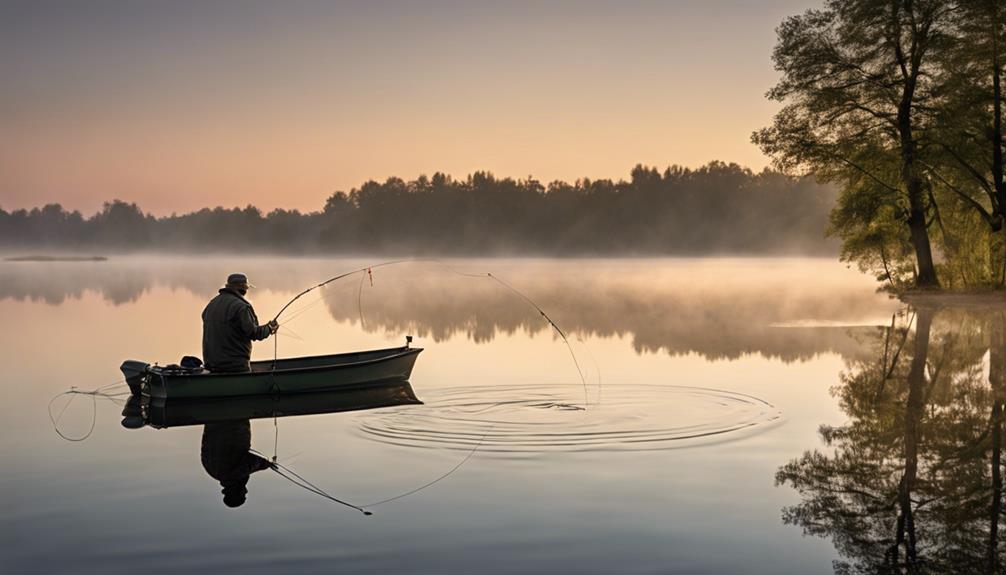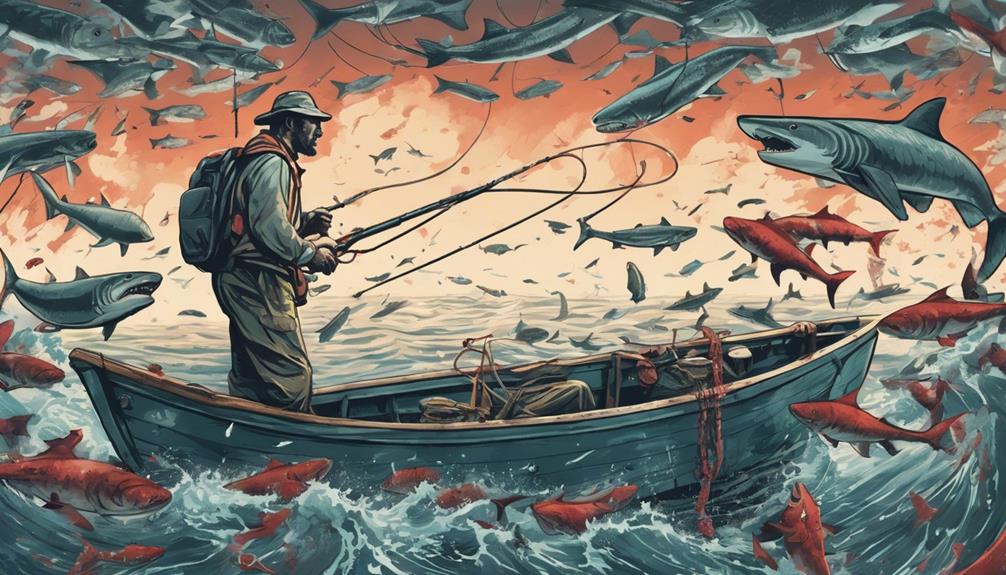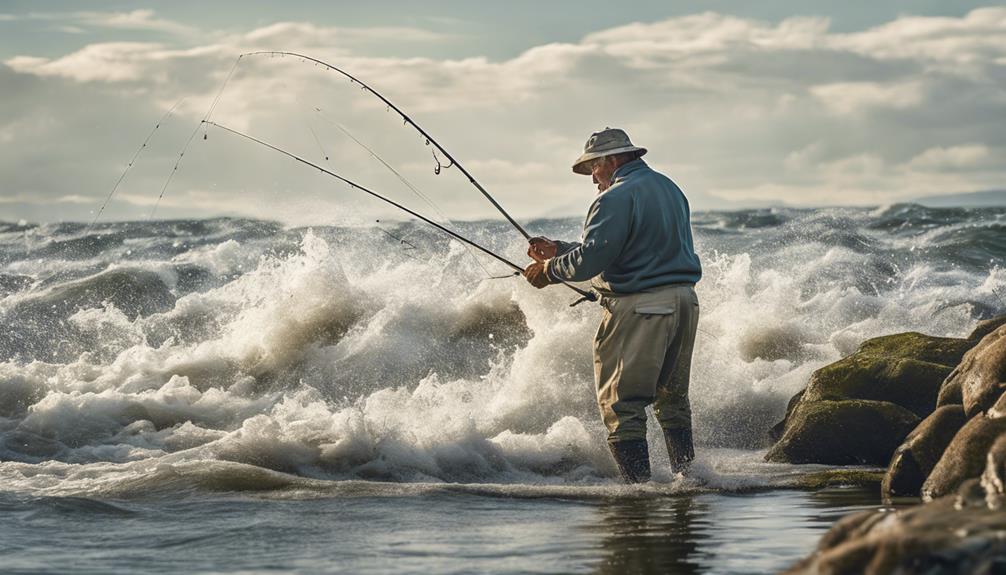When it comes to reeling in those elusive northern pike, having a few tricks up your sleeve can make all the difference. From mastering the art of jigging to strategically using live bait, there are several effective techniques that can significantly boost your chances of a successful catch.
But what about those topwater lure techniques or understanding pike behavior? Stay tuned to uncover these secrets and more that will take your pike fishing game to the next level.
Locating Northern Pike
When searching for Northern Pike, always focus on areas with dense vegetation and ample cover to increase your chances of success. These areas serve as hotspots for Northern Pike as they offer protection and ambush points for these predatory fish. Look for locations such as weed beds, submerged logs, rocky points, and underwater structures where Northern Pike are likely to hide and wait for their prey.
Depth exploration is crucial when targeting Northern Pike. These fish tend to inhabit different depths based on the season and water temperature. In the warmer months, they may be found in shallower waters near the shore, especially in the early morning or late evening when they're actively feeding. As the day progresses and temperatures rise, they often move to deeper, cooler waters. In colder months, Northern Pike may stay in deeper areas where the temperature is more stable.
To find Northern Pike effectively, consider using a fishfinder to locate underwater structures and changes in depth. Pay attention to drop-offs, submerged vegetation, and areas where baitfish are present, as Northern Pike are likely to be nearby. By exploring different depths and focusing on areas with ample cover, you can increase your chances of locating and catching Northern Pike successfully.
Using Live Bait Strategically
For effective Northern Pike fishing, strategically utilizing live bait can significantly increase your chances of attracting and hooking these predatory fish. When it comes to live bait selection, opt for large minnows like suckers or chubs, as Northern Pike are known to prefer sizable prey. Make sure the live bait is lively and healthy to entice the pike effectively.
In terms of presentation tactics, consider using a quick-strike rig to ensure a higher hookup ratio when the pike strikes. This rig allows for a more immediate hookset, preventing the pike from swallowing the bait deeply, which can make unhooking more challenging. When setting up the rig, adjust the leader length according to the water clarity; shorter leaders in murky water and longer leaders in clear water can make a difference in getting the pike's attention.
Additionally, vary your retrieval speed and depth to mimic injured prey and trigger the pike's predatory instincts. Jerk the bait occasionally to create erratic movements that can attract nearby pike. Remember to stay patient and observant, as pike can sometimes follow the bait before striking. By combining strategic live bait selection with effective presentation tactics, you can improve your chances of a successful Northern Pike fishing excursion.
Mastering the Art of Jigging
To master the art of jigging effectively while Northern Pike fishing, focus on precision and control in your movements to entice and hook these predatory fish. When it comes to jigging finesse and depth control, following these tips can significantly improve your success rate:
- Adjust Your Jigging Depth: Experiment with different depths until you find where the pike are lurking. Use a fish finder to locate the pike, then adjust your jigging depth accordingly. Keep your jig at the right level to attract bites effectively.
- Use the Right Equipment: Equip yourself with the essentials for jigging, including a quality rod, reel, and line. Choose a sensitive rod to feel the subtle bites of Northern Pike. Additionally, consider using braided line for better sensitivity and hook-setting power. Refine your technique by practicing with your gear before hitting the water.
- Master Jigging Techniques: Practice different jigging motions to find what works best. Try a combination of short, sharp jerks and longer sweeps to mimic injured prey. Remember to vary your retrieve speed to entice strikes from these aggressive predators.
Topwater Lure Techniques
As you transition from mastering the art of jigging, now focus on mastering effective topwater lure techniques for Northern Pike fishing. When using topwater lures, you aim to entice the pike to strike at the surface, creating an exhilarating experience as you witness explosive surface strikes. To increase your chances of success, proper lure selection is crucial.
When selecting topwater lures for Northern Pike, consider choosing large, noisy lures that mimic wounded prey. Pike are aggressive predators and are drawn to the commotion created by these lures. Popular choices include buzzbaits, propeller lures, and frogs. Experiment with different colors and sizes to determine what the pike in your area prefer.
To maximize your chances of a surface strike, vary your retrieval speed. Start with a steady retrieve, and if that doesn't attract any attention, try a stop-and-go technique. The stop-and-go method can mimic injured prey struggling on the surface, tempting the pike to strike.
When casting your topwater lure, aim for areas with vegetation, logs, or other structures where pike may be lurking. These ambush points are where pike are likely to strike at passing prey. Work your lure along the edges of these structures, creating enticing movements to trigger a strike.
Trolling for Pike Success
Have you considered incorporating trolling techniques for maximizing your success in catching Northern Pike? Trolling can be a highly effective method for targeting these aggressive predators. By implementing the right strategies, you can significantly increase your chances of hooking into some impressive Pike.
Here are some trolling tips and lure selection recommendations to help you reel in more Pike:
- Adjust Your Speed: Experiment with different trolling speeds to find the optimal pace that entices Pike to strike. Sometimes a faster speed can trigger a more aggressive response, while other times a slower pace may be more effective. Pay attention to the behavior of the fish and adjust your speed accordingly.
- Use Diving Crankbaits: Select diving crankbaits that can reach the depths where Pike are likely to be lurking. Look for lures that have a realistic swimming action and resemble the local forage fish. Bright colors or patterns that create a contrast in the water can attract the attention of Pike.
- Consider Inline Spinners: Inline spinners are another excellent choice for trolling for Pike. Their spinning blades create vibrations and flashes that can trigger a Pike's predatory instincts. Choose inline spinners in various sizes and colors to determine what the fish are responding to best.
Understanding Pike Behavior
Explore how Northern Pike behavior can impact your fishing success, guiding your tactics towards a more fruitful angling experience. Observing movements and habits of Northern Pike is crucial for a successful fishing trip. These predatory fish are known for their ambush hunting style. They often lurk near vegetation, drop-offs, or other structures, waiting to strike at passing prey. By understanding their preferred habitats and typical hiding spots, you can increase your chances of landing a catch. Pay attention to how they react to different weather conditions and times of day, as this can influence their activity levels.
Learning feeding patterns is another essential aspect of understanding Pike behavior. Northern Pike are opportunistic feeders, meaning they'll go after a variety of prey depending on availability. They commonly prey on smaller fish, such as perch or minnows, but they're also known to eat insects, frogs, and even small mammals. By knowing what they typically feed on in a specific area, you can tailor your bait selection to match their preferences. Additionally, understanding when Pike are most active in terms of feeding can help you plan your fishing trips for optimal success.
Setting the Hook Properly
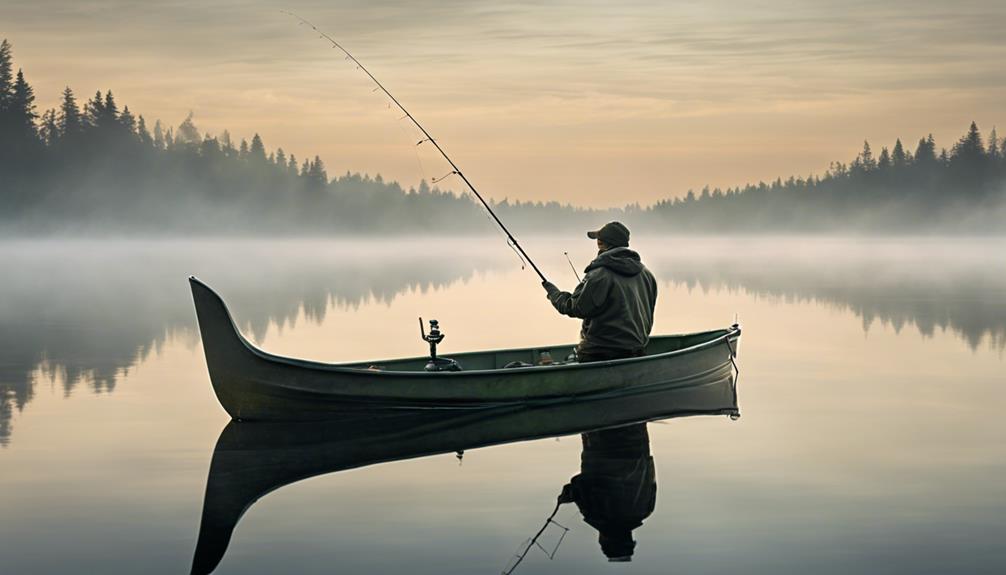
To ensure a successful catch when fishing for Northern Pike, mastering the technique of setting the hook properly is paramount. A proper hookset can mean the difference between landing a trophy-sized pike or watching it swim away.
Here are some key tips to help you perfect your hook-setting skills:
- Maintain Tension: Once you feel a pike strike, resist the urge to immediately jerk the rod. Instead, keep steady pressure on the line to ensure the hook penetrates the fish's bony mouth.
- Timing Accuracy: Timing is crucial when setting the hook. Wait for the pike to fully commit to the bait before setting the hook. If you strike too soon, you may pull the lure out of the fish's mouth. If you wait too long, the pike may spit out the bait.
- Use a Firm Hookset: When you're ready to set the hook, do so with a swift and firm motion. A strong hookset is essential for driving the hook home and keeping the pike hooked during the fight.
Handling and Releasing Northern Pike
Properly handling and releasing Northern Pike after catching them is crucial for their survival and the sustainability of the fishery. When you land a Northern Pike, ensure you handle it with care to minimize stress and potential injuries to the fish. Avoid squeezing the fish or touching its gills as this can harm them. Instead, use wet hands or a rubberized landing net to hold the fish gently. Keep the fish in the water as much as possible while removing the hook. If the fish is deeply hooked, consider cutting the line instead of causing further damage by trying to remove the hook.
Conservation techniques are essential when releasing Northern Pike. Support the fish in the water until it can swim away on its own. Avoid tossing the fish back or letting it flop on the shore. Pike are resilient, but improper handling can decrease their chances of survival after release. If you must handle the fish out of the water for a quick photo, do so minimally and support the fish properly. Remember, the goal is to ensure that the fish remains healthy and has the best chance of thriving post-release.
Frequently Asked Questions
What Is the Best Time of Year to Target Northern Pike?
When targeting northern pike, the best time of year is typically during the spring and fall seasons. Prime locations for catching these fish include weed beds and rocky areas.
The best baits to use are large spoons, crankbaits, and live minnows. Northern pike are most active when the water temperature is between 50-65 degrees Fahrenheit.
Successful strategies involve casting near structure and using erratic movements to entice strikes.
Are There Any Specific Weather Conditions That Can Affect Northern Pike Fishing?
Windy conditions and overcast skies can greatly affect northern pike fishing. Pike are more active during low light conditions, so overcast days can lead to increased success. Wind can also push baitfish closer to shore, attracting pike.
Solar activity and moon phases can influence their feeding behavior, with pike often more active during dawn and dusk. Keeping an eye on these weather conditions and celestial events can improve your chances of a successful pike fishing trip.
How Can I Effectively Target Larger Northern Pike?
To effectively target larger northern pike, focus on lure selection and hook size. Opt for larger lures like spoons or crankbaits to entice big fish. Use strong hooks to handle their size and strength.
Position your boat strategically near weed beds or drop-offs where pike like to hide. Ensure your line strength is sufficient to handle their powerful runs. By combining these tactics, you increase your chances of landing a trophy-sized pike.
Are There Any Specific Techniques for Fishing for Northern Pike in Shallow Water?
When fishing for northern pike in shallow water, consider your lure selection carefully. Opt for flashy spoons or jerkbaits to attract their attention.
Master your casting techniques to accurately place your bait near potential hiding spots. Use shallow water strategies like slowly retrieving your lure to mimic injured prey.
Position your boat strategically to cover a wide area and increase your chances of hooking a pike.
What Are Some Common Mistakes Anglers Make When Fishing for Northern Pike?
When fishing for northern pike, common mistakes anglers make include improper lure selection and setting the hook too soon. Choosing the right lure that mimics the pike's natural prey is crucial.
Also, patience is key when setting the hook. Wait for the pike to fully take the bait before setting the hook with a swift and strong motion. Avoid rushing the process to increase your chances of a successful catch.
Conclusion
Now that you have learned these 9 effective techniques for northern pike fishing, you're well-equipped to tackle this exciting sport with confidence.
Remember to locate pike hotspots, strategically use live bait, and master jigging and trolling techniques.
Understanding pike behavior, setting the hook properly, and handling and releasing them responsibly are key to a successful fishing trip.
Get out there and put these techniques to the test for a thrilling pike fishing adventure!
